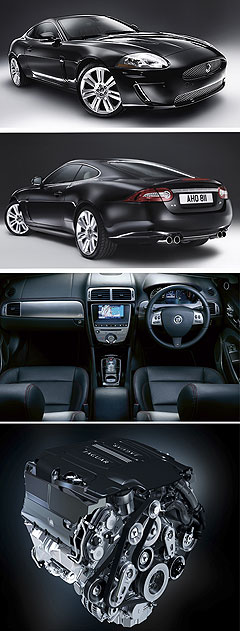Jaguar upgrades sexy XK
BY MARTON PETTENDY | 1st Sep 2009

Biggest change is the fitment of the Indian-owned, British brand’s new direct-injection 5.0-litre petrol V8 engines that debuted here in the upgraded XF large sedan in August and which will power the next-generation XJ limousine in Australia from March next year.
The same new naturally-aspirated and supercharged V8s will also appear in Land Rover’s 10MY Discovery and Range Rover Sport and Vogue models later this year.
While the new engines deliver significant gains in power, torque, performance and CO2 emissions (but not fuel consumption), they don’t come for free, and in this case the entry-level XK Coupe price will increase by almost $15,000 – from $209,400 to $224,200. The XK Convertible will also be $14,800 more expensive, at $247,500.
The supercharged hard-top and soft-top XKR models cop an even larger price increase of $14,900, with the XKR Coupe to cost $255,000 (up from $240,100) and the XKR Convertible again topping the range at $278,300 – up from $263,400.
Complemented by revised interior and exterior styling, the new AJ-V8 Gen III engines are claimed to be the most efficient produced by Jaguar.

That’s up a respective 26 and 23 per cent from 224kW/420Nm for the current XK’s 4.2-litre V8, and a respective 23 and 12 per cent from 306kW/560Nm for the current XKR engine.
Matched as standard to Jaguar’s six-speed ZF 6HP28 automatic transmission, which can be operated either via steering wheel paddles or the new-for-2010 JaguarDrive Selector from the XF and XJ, all models have an electronically limited top speed of 250km/h.
In terms of 0-100km/h acceleration, however, Jaguar claims the standard XK Coupe is seven-tenths quicker (5.5 seconds versus its predecessor’s 6.2), while the supercharged XKR Coupe is four-tenths quicker, from 5.2 to 4.8 seconds.
Both XKR models also benefit from a new electronically controlled Active Differential Control system.
Efficiency gains are less impressive, with Jaguar claiming that fuel consumption is “comparable to the previous generation of XK”, while CO2 emissions are reduced by two per cent for the normally-aspirated V8 and one per cent for the supercharged V8.
The XKR’s average fuel economy figure of 12.3 litres per 100km is unchanged, while its CO2 output is reduced to 292 grams per 100km. The XK, meantime, also returns near-identical 11.2L/100km and 264g/km efficiency figures.
Fitted with Jaguar’s new spray-guided direct-injection (SGDI) system and dual independent variable cam timing (DIVCT), both of the 10MY XK’s all-aluminium quad-camV8 engines meet strict new Euro 5 emissions regulations.
Interior quality and overall specification levels are said to improve via new interior trims and finishes, plus a seat heating and cooling function for the new 16-way power-adjustable leather-trimmed front seats with memory and adjustable side bolsters.
Extras include bright treadplate inserts, white instrument faces with red pointers, a revised steering wheel with leather-clad lower spoke, saddle-stitched door trims with modified seat switch panels, new Ivory seat and Oyster cabin trim, new Oak (XK) and Dark Oak (XKR) woodgrain trim options, plus Knurled Aluminium veneer (XK) and Dark Mesh Aluminium (XKR) options.
Externally, the 10MY XK 2+2-seater is differentiated by a new front bumper, new side mirrors with integrated LED indicators, a new lower rear body valance, new LED tail-lights incorporating foglights and twin reversing lights and colour-coded side power vents for both the coupe and convertible.
New alloy wheel designs include a 19-inch ten-‘V’-spoke Caravela wheel as standard for the XK and a twin-five-spoke 20-inch Kalimnos wheel for the XKR. A twin-seven-spoke R Performance Nevis design will be a unique new option for the XKR.
Recent new exterior paint colour options including Claret, Spectrum Blue and Kyanite Blue bring to 15 the number of body colour choices for the XK – two of which are reserved exclusively for the XKR – Salsa and Kyanite Blue.
The XKR continues to be set apart by a chromed mesh lower grille, which is black on the XK, plus revised exhaust outlets and a body-coloured rear valance.
“With an all-new, supercharged AJ-V8 engine and dramatic new looks, the new XKR has all the performance, power and panache that you expect in the ultimate sporting Jaguar,” said Jaguar Cars managing director Mike O’Driscoll.
“The XK has always been an exceptional sportscar. Now, it has evolved into something even more exhilarating, combining Jaguar’s legendary performance, new advanced technologies and crafted luxury to create a sportscar without parallel.”
| Jaguar 10MY XK pricing: | |
| XK Coupe (a) | $224,200 |
| XK Convertible (a) | $247,500 |
| XKR Coupe (a) | $255,000 |
| XKR Convertible (a) | $278,300 |